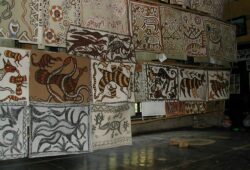Enigmatic Elegance: The Haunted Mansion Paintings
 Posted On
Posted On
In the world of art, there exists a genre that transcends conventional beauty, evoking a sense of mystery, foreboding, and allure. These are the haunted mansion paintings, a subgenre of Gothic art that has captivated the imaginations of art enthusiasts and paranormal enthusiasts alike. Within their eerie frames lies a fascinating tale of artistic mastery intertwined with the supernatural.
The haunted mansion paintings have a long and storied history, dating back to the late 18th century when Gothic literature and art were in vogue. The Romantic movement of the time celebrated the macabre, and artists sought to capture the eerie atmosphere of decaying mansions, overgrown gardens, and ghostly apparitions on canvas. One of the earliest and most renowned works in this genre is “The Abbey in the Oakwood” by Caspar David Friedrich, a masterpiece that set the tone for many to follow.
These paintings often feature imposing, decrepit manors, enveloped in an otherworldly mist. The architecture appears both awe-inspiring and menacing, with its intricate details highlighting the passage of time and the inexorable decay of once-grand structures. These mansions stand as silent witnesses to a bygone era, shrouded in secrets that only the most curious and courageous would dare to unearth.
The true allure of haunted mansion paintings lies in their ability to evoke a profound sense of unease in viewers. The artists employ a variety of techniques to achieve this, from the use of stark contrasts between light and shadow to the incorporation of subtle details that hint at a lingering malevolence. Windows emit an eerie glow, suggesting the presence of unseen souls, while gnarled trees and twisted vines reach out like skeletal fingers, grasping at the mansion’s façade.
In some of the most famous haunted mansion paintings, spectral figures roam the premises. These ethereal beings are often clad in tattered, era-appropriate attire, lending an air of authenticity to their haunting presence. They wander aimlessly through dimly lit hallways, their faces obscured by shadows, leaving viewers to wonder about the stories behind their eternal torment.
One such iconic work is John Atkinson Grimshaw’s “Spirit of the Night.” In this hauntingly beautiful painting, a cloaked figure, bathed in an otherworldly glow, hovers above a misty landscape. The spectral presence appears simultaneously ethereal and malevolent, leaving viewers entranced and unsettled.
Haunted mansion paintings are not only a testament to artistic skill but also an exploration of the human fascination with the unknown and the supernatural. They tap into our deepest fears and curiosities, inviting us to peer into the darkest corners of our imagination. These works are a testament to the enduring power of Gothic aesthetics and the timeless allure of the macabre.
Over the centuries, the haunted mansion genre has continued to evolve, influenced by changing artistic styles and cultural shifts. Modern artists have embraced the challenge of breathing new life into this time-honored tradition, infusing it with contemporary elements while paying homage to its roots. The result is a diverse body of work that continues to captivate and inspire.
In conclusion, haunted mansion paintings stand as a unique and enduring genre within the art world. They transport us to a world of decaying grandeur, spectral inhabitants, and enigmatic atmospheres. These works of art challenge us to confront our deepest fears and curiosities while celebrating the beauty that can be found in the darkest of places. Whether you are a fan of Gothic art, a lover of the supernatural, or simply an admirer of the macabre, haunted mansion paintings offer a hauntingly beautiful journey into the realm of the unknown.



